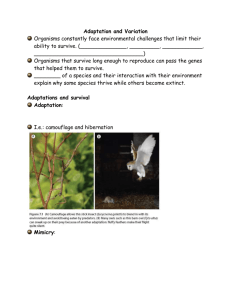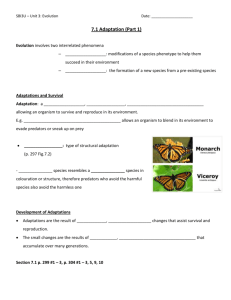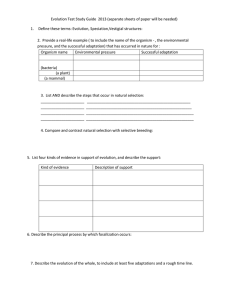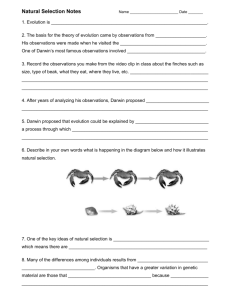7.1: Adaptation and Variation pg. 296 - 304 Key Terms:
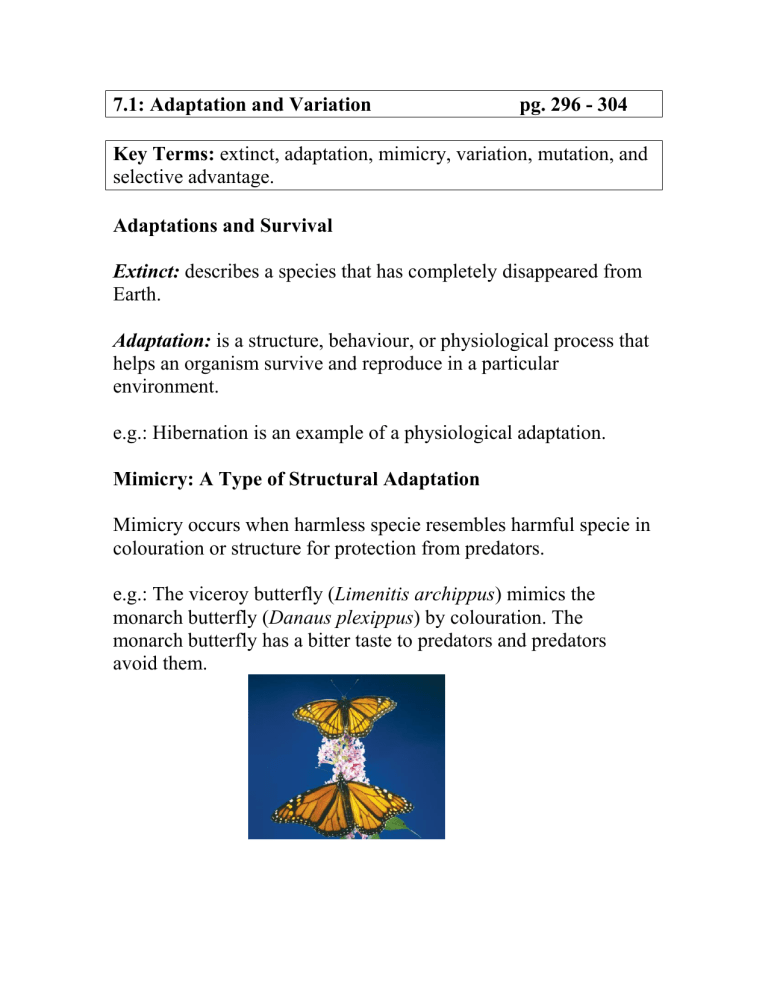
7.1: Adaptation and Variation pg. 296 - 304
Key Terms: extinct, adaptation, mimicry, variation, mutation, and selective advantage.
Adaptations and Survival
Extinct: describes a species that has completely disappeared from
Earth.
Adaptation: is a structure, behaviour, or physiological process that helps an organism survive and reproduce in a particular environment. e.g.: Hibernation is an example of a physiological adaptation.
Mimicry: A Type of Structural Adaptation
Mimicry occurs when harmless specie resembles harmful specie in colouration or structure for protection from predators. e.g.: The viceroy butterfly ( Limenitis archippus ) mimics the monarch butterfly ( Danaus plexippus ) by colouration. The monarch butterfly has a bitter taste to predators and predators avoid them.
Development of Adaptation
Variation: are differences between individuals, which may be structural, functional, or physiological.
Adaptations are the result of gradual, accumulative changes that helps an organism survive and reproduce. These changes are random and genetic inheritable mutations that accumulate over time.
Not all variations will become adaptations. The environment is a factor in determining whether the variations have a positive or negative effect on an organism’s ability to survive or reproduce. If the variation is helpful, it may increase the organism’s ability to survive and pass the variation onto the next generation. As the variation becomes more frequent within the population, it considered a characteristic or trait.
Environments change over time, such as; climate, and human activities, which may give the organism an advantage or disadvantage, critical to its survival. e.g.: English Pepper moth.
The English Peppered Moth: Variation to Adaptation
The proportions of an inherited characteristic in a population can change in response to the changes in the environment. The pepper moth has 3 variations in colour; grayish-white flecked with black dots (pepper), black, and an intermediate colour.
The black variety was rare, 1848, making up less than 2% of the population. By 1898, 95% of the moth population was black. The event occurred in the city limits of Manchester, but maintained similar 1848 proportions in the rural areas.
The Peppered Moth and Pollution
During the day the moths rest in trees where they are camouflaged from predator birds. The lighter coloured moths blended with the light colour lichen growing on the trees. The black colour moths were easy to see and easy prey for the birds.
During the industrial revolution, air pollution killed the lichen and soot covered the trees, making the bark dark. The black moths were now camouflaged and the lighter coloured moths fell prey to the birds. This changed the proportions of the population from
1848 to 1898. The black moths were able to reproduce and their offspring had a better chance of survival.
In 1950 clean air legislation was enacted, the lichen started to grow back, and the flecked moths population started to increase and the black decreased, going from 9 out of 10, to 5 out of 10 by 1985, and 3 out of 10 in 1989.
Figure 7.3: The proportion of flecked and black moths in this population of peppered moths changed in response to changes in the environment.
Learning Check, questions 1 – 6, pg. 299
Variation within Species
The number of possible combinations of genes that offspring can inherit from their parents results in greater genetic variation among individuals, crossing over and independent assortment
(2
23
= 8 388 608).
Genetic variation in a population results from the variety of genetic information in all individuals of the population. A second source of genetic variation is gene flow (the net movement of alleles from one population to another due to migration of individuals).
Figure 7.4: The kittens in this litter have different fur colour and patterns, partly because each kitten inherited a different combination of alleles from its parents.
Mutations Lead to Genetic Variation
Mutation is a permanent change in the genetic material of an organism; the only source of new genetic variation.
Mutations provide new alleles in a species and are the only source of new genetic variation. DNA is continuously being mutated during the S-phase of the cell cycle. Mutagens like; ultraviolet radiation , are environmental agents that may also cause genetic mutations.
If a mutations should occur, the cell may die, malfunction, or multiply rapidly ( cancer ) causing a tumour. Mutations can be beneficial, neutral, or harmful.
Mutations in Gamete Cells
If a mutation should occur in a somatic cell , it only affects the organism, and it is not passed on to the next generation, it will also disappear from the population when the organism dies.
If the mutation should change the DNA in a sex cell ( gamete ), it will be passed on to the next generation as a new allele. This is the starting point for genetic variation within a population.
Mutations Can Provide a Selective Advantage
Selective advantage is a genetic advantage that improves and organism’s chance of survival, usually in a changing environment.
In a changing environment, a mutation which may have been a disadvantage may become a favourable trait in the population. This can become an advantage of one organism over another competitor.
The variation may increase the organism’s chance of survival and reproduction in the changing environment.
Rapid Reproduction and Selective Advantage
Organisms that reproduce very quickly and in large numbers, with a new allele, from a random mutation, will provide a selective advantage to the organism as the environment changes. The allele is passed on from generation to the next generation. The new allele appears more often within the population.
Antibiotic-Resistant Bacteria
Staphylococcus aureus bacterium is an example of rapid reproduction and selective advantage. The bacteria can reproduce every 30 minutes, which can support the adaptations insertion into the population. This can cause problems for doctors trying to treat the infection. The bacteria population may become resistant to antibiotics through the introduction of a new allele into the population.
Figure 7.6: These Staphylococcus aureus bacteria appear to be identical, but some may have a mutation that makes them resistant to antibiotics.
Review Questions: 1 – 14 pg. 304
Activity 7.1: Modeling Adaptations, 1 – 3, pg. 298
Activity 7.2: Tuberculosis: Adapting Populations of Bacteria
Thought Lab 7 – A: Investigating Mimicry, pg. 312 – 313
Study Guide: Self Assessment ,1 – 13, SG. 104 – 105
Adaptation and Variation (7.1),1 – 5, SG. 106 – 107
Variations, Mutations, and Selective Advantages (7.1),1 – 4
SG. 108 – 109
